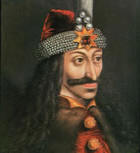 |
|||||||||||||||
|
|
|
|
|||||||||||||
by Beverley Richardson
Vampire myths go back thousands of years and occur in almost every culture around the world. Their variety is almost endless; from red eyed monsters with green or pink hair in China to the Greek Lamia which has the upper body of a woman and the lower body of a winged serpent; from vampire foxes in Japan to a head with trailing entrails known as the Penanggalang in Malaysia.
However, the vampires we are familiar with today, although mutated by fiction and film, are largely based on Eastern European myths. The vampire myths of Europe originated in the far East, and were transported from places like China, Tibet and India with the trade caravans along the silk route to the Mediterranean. Here they spread out along the Black Sea coast to Greece, the Balkans and of course the Carpathian mountains, including Hungary and Transylvania.
Our modern concept of the vampire still retains threads, such as blood drinking, return from death, preying on humans at night, etc in common with the Eastern European myths. However many things we are familiar with; the wearing of evening clothes, capes with tall collars, turning into bats, etc are much more recent inventions.
On the other hand, many features of the old myths such as the placing of millet or poppy seeds at the gravesite in order to keep the vampire occupied all night counting seeds rather than preying on relatives, have all but disappeared from modern fiction and film.
Even among the Eastern European countries there is a large variety of vampires:
SLAVIC VAMPIRES
ROMANIA
GYPSIES AND VAMPIRES
EIGHTEENTH CENTURY VAMPIRE CONTROVERSY
|
|||||||||||||||
|
|||||||||||||||

